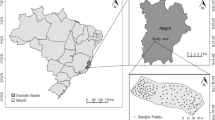Abstract
Coffee rust is a devastating disease but its paratism by Lecanicillium lecanii is assumed as having little role in the disease progress. However, recent evidence showed that the ecology of the multitrophic interaction is more complex but the factors that contribute for Hemileia vastatrix parasitism have only started to be addressed. Surveys of rust and its parasitism in a coffee plantation where no fungicide was used were carried out to find out the contribution of the plant characteristics and environmental conditions on the dynamics of coffee rust and its parasitism by L. lecanii. Throughout the year, rust incidence/severity and hyperparasite presence were assessed monthly on leaves. The maximum parasitism was found in the dry season with high rates on the east-facing side of the plant rather than on the west-facing side. There was a positive correlation between hyperparasite incidence and rust incidence/severity, regardless of the plant parts or season and a stronger correlation in the upper part of the plant. H. vastatrix and L. lecanii were more frequently found at higher temperatures. The abiotic environmental factors as well as plant features play a strong role in epidemic rust and on its natural enemy. The results from this work showed that disease control strategies should take such factors and plant features into consideration in the integrated management of coffee rust, to rationally manage fungicide application and therefore both reduce production costs and the risk of the emergence of fungicide insensitive H. vastatrix populations.


Similar content being viewed by others
References
Avelino J, Zelaya H, Merlo A, Pineda A, Ordoñez M, Savary S (2006) The intensity of a coffee rust epidemic is dependent on production situations. Ecol Model 197(3–4):431–447. doi:10.1016/j.ecolmodel.2006.03.013
Boldini J M (2002) Epidemiologia da ferrugem e da cercosporiose em cafeeiro irrigado e fertirrigado Dissertation, Universidade Federal de Lavras
Capucho AS, Zambolim L, Lopes UN, Milagres NS (2013) Chemical control of coffee leaf rust in Coffea canephora cv. conilon. Australas Plant Pathol 42(6):667–673. doi:10.1007/s13313-013-0242-y
Colto L, Mourad AL, Oliveira PAPL, Baddini JPOA, Kletecke RM (2006) Environmental profile of Brazilian green coffee. Int J Life Cyc AssesS 11(1):16–21. doi:10.1065/lca2006.01.230
Cunha R. L., Pozza E. A., Dias W. P., Barretti P. B. (2001) Desenvolvimento e validação de uma escala diagramática para avaliar a severidade da ferrugem (Hemileia vastatrix) do cafeeiro. http://www.sbicafe.ufv.br/bitstream/handle/10820/469/155585_Art148f.pdf?sequence=1. Accessed 24 July 2014
Fernandez D, Santos P, Agostini C, Bon MC, Petitot AS, Silva MC, Guerra-Guimarães L, Ribeiro A, Argout X, Nicole M (2004) Coffee (Coffea arabica L.) genes early expressed during infection by the rust fungus (Hemileia vastatrix). Mol Plant Pathol 5(6):527–536. doi:10.1111/J.1364-3703.2004.00250.X
Garçon C. P., Zambolim L., Vale F. X. R., Costa H., Silva M. B. (2000) Progresso da ferrugem (Hemileia vastatrix Berk. et Br.) do cafeeiro (Coffea arabica L.) em diferentes altitudes. http://www.sbicafe.ufv.br/bitstream/handle/10820/376/155537_Art064f.pdf?sequence=1. Accessed 19 January 2014
Grasso V, Palermo S, Sierotzki H, Garibaldi A, Gisi U (2006) Cytochrome b gene structure and consequences for resistance to Qo inhibitor fungicides in plant pathogens. Pest Manag Sci 62:465–472. doi:10.1002/ps.1236
Haddad F, Maffia LA, Mizubuti ESG, Teixeira H (2009) Biological control of coffee rust by antagonistic bacteria under field conditions in Brazil. Biol Control 49(2):14–119. doi:10.1016/j.biocontrol.2009.02.004
Islam MS, Ali M, Rahman MS (2011) In vitro studies on the fungicidal effect on Trichoderma species in tea plantation. Banglad. J Agric Res 36(4):677–683. doi:10.3329/bjar.v36i4.11758
Jackson D, Zemenick K, Huerta G (2012) Occurrence in the soil and dispersal of Lecanicillium lecanii, a fungal pathogen of the green coffee scale (Coccus viridis) and coffee rust (Hemileia vastatrix). Trop Subtrop Agroecosyst 15(2):389–401
Kouvelis VN, Zare R, Bridge PD, Typas MA (1999) Differentiation of mitochondrial subgroups in the Verticillium lecanii species complex. Lett Appl Microbiol 28(4):263–268. doi:10.1046/j.1365-2672.1999.00530.x
Loland J, Singh B (2004) Copper contamination of soil and vegetation in coffee orchards after long-term use of Cu fungicides. Nutr Cycl Agroecosyst 69(3):203–211. doi:10.1023/B:FRES.0000035175.74199.9a
López-Bravo DF, Virginio-Filho EM, Avelino J (2012) Shade is conducive to coffee rust as compared to full sun exposure under standardized fruit load conditions. Crop Prot 38:21–29. doi:10.1016/j.cropro.2012.03.011
Luaces O, Rodrigues LHA, Meira CAA, Bahamonde A (2011) Using nondeterministic learners to alert on coffee rust disease. Expert Syst Applic 38(11):14276–14283. doi:10.1016/j.eswa.2011.05.003
Maffia LA, Haddad F, Mizubuti ESG (2009) Controle biológico da ferrugem do cafeeiro (ISBN 9788585771485). In: Bettiol W, Morandi MAB (eds) Biocontrole de doenças de plantas: usos e perspectivas, 1st edn. Embrapa Meio Ambiente, Jaguariúna, pp 267–275
McCook S (2006) Global rust belt: Hemileia vastatrix and the ecological integration of world coffee production since 1850. J Glob Hist 1(2):177–195. doi:10.1017/S174002280600012X
Mckinney RH (1923) Influence of soil temperature and moisture on infection of wheat seedlings by Helminthosporium sativum. J Agric Res 26(5):195–218
Vandermeer J, Perfecto I, Liere H (2009) Evidence for hyperparasitism of coffee rust (Hemileia vastatrix) by the entomogenous fungus, Lecanicillium lecanii, through a complex ecological web. Plant Pathol 58(4):636–641. doi:10.1111/j.1365-3059.2009.02067.x
Zare R, Gams W (2001) A revision of Verticillium sect. Prostrata. IV. the genus Lecanicillium and the new genus Simplicillium. Nova Hedwigia 73(1–2):1–50
Acknowledgments
We thank the Conselho Nacional de Desenvolvimento Cientifico Cultural (CNPq) for providing financial support grant 480216/2013-4 awarded to the corresponding author and scholarship to the last author, Fundação de Apoio à Pesquisa do Estado de Minas Gerais (FAPEMIG) grand APQ2059-13 and Coordenação de Aperfeiçoamento de Pessoal de Nível Superior (CAPES) PROAP for providing the financial support necessary for the development of this work and scholarship to the first author. We also thank Caroline Ruppert for providing an English review of the manuscript.
Author information
Authors and Affiliations
Corresponding author
Rights and permissions
About this article
Cite this article
Martins, S.J., Soares, A.C., Medeiros, F.H.V. et al. Contribution of host and environmental factors to the hyperparasitism of coffee rust under field conditions. Australasian Plant Pathol. 44, 605–610 (2015). https://doi.org/10.1007/s13313-015-0375-2
Received:
Accepted:
Published:
Issue Date:
DOI: https://doi.org/10.1007/s13313-015-0375-2




